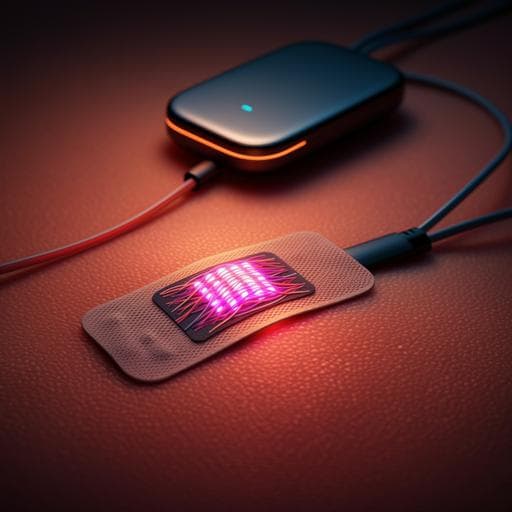
Engineering and Technology
Thread-based multiplexed sensor patch for real-time sweat monitoring
T. Terse-thakoor, M. Punjiya, et al.
Discover the revolutionary thread-based multiplexed sensing patch for real-time monitoring of sweat biomarkers, developed by a talented team including Trupti Terse-Thakoor and Meera Punjiya from Tufts University. This innovative device ensures continuous on-body measurements, integrating seamlessly with smartphones for instant data access.
~3 min • Beginner • English
Introduction
The study addresses the need for minimally invasive, real-time monitoring of metabolic biomarkers in sweat to assess health, athletic performance, and clinical status. Sweat is a rich, easily accessible biofluid whose analyte levels correlate with blood plasma. Prior flexible and textile-based sensor platforms face challenges including non-uniform deposition on fabrics, difficulty integrating rigid electronics, and limited real-time sampling of fresh sweat. The authors propose a fully integrated, textile thread-based multiplexed sensing patch capable of continuous, simultaneous detection of sodium, ammonium, lactate, and pH directly from sweat, with wireless readout, to enable real-time physiological monitoring during exercise and stress.
Literature Review
The introduction surveys wearable sweat sensing modalities including tattoos, sweatbands, and flexible polymer-based devices, as well as paper and microfluidic platforms. It highlights limitations of on-fabric screen-printing or dip-coating (non-uniformity due to wicking on textured surfaces and limited adaptability to existing garments) and challenges integrating rigid electronics with flexible sensors. Textile-based approaches offer breathability and compatibility with clothing but often lack continuous fresh sweat sampling. Prior demonstrations include colorimetric fabric sensors for pH and lactate, potentiometric textile pH sensors, and thread-based microfluidics and sensors for tissue monitoring and wound care. Carbon nanotube-infused thread electrodes for potentiometric sensing of potassium, ammonium, and pH have also been reported. The authors build on a bottom-up approach using individually functionalized threads stitched into platforms, aiming to overcome uniformity, integration, and continuous sampling issues.
Methodology
Sensor substrates and fabrication: Polyester (PE) and stainless steel (SS) threads were pretreated (isopropanol soak, air plasma) to remove wax and render hydrophilic. Conductive coatings were applied by multiple dip-coatings and baking at 60°C for 30 min per coat. Carbon ink-coated PE threads (C/PE) served as working electrodes; Ag/AgCl ink-coated PE threads (Ag/AgCl/PE) served as references. SS threads were coated with carbon ink (C/SS) for pH sensing.
Sensor functionalization:
- Ion-selective electrodes (ISEs): Ammonium-selective membrane (nonactin, o-NPOE, PVC in THF) and sodium-selective membrane (sodium ionophore X, Na-TFPB, PVC, DOS in THF) were prepared, ultrasonicated, and stored at ~4°C. C/PE threads were dip-coated (NH4+: four layers; Na+: three layers), dried overnight, and stored at 4°C.
- pH sensor: Polyaniline (PANI) was electrodeposited chronopotentiometrically on C/SS threads using an aniline solution at 150 µA for 70 s in a three-electrode setup (C/SS WE, Ag/AgCl RE, Pt counter). Threads were rinsed post-deposition.
- Lactate sensor: Prussian blue (PB)-mediated carbon ink was coated on PE threads and cured; dielectric ink defined active area. A chitosan solution (1% w/v in 0.1 M acetic acid, diluted 1:1 with PBKCl) was drop-cast, followed by lactate oxidase (45 mg/mL in PBKCl) and another chitosan layer. Threads were stored at 4°C.
- Solid-state reference: Ag/AgCl/PE threads were dip-coated with a PVB cocktail (PVB + NaCl in methanol), dried, and used the next day.
Patch assembly: Sensing and reference threads were assembled onto a commercial adhesive bandage. An adhesive hydrophobic film was placed centrally; threads (working, reference, and counter for amperometry) were positioned; dielectric ink and patterned insulating film defined sensing areas. Thread ends were coated with silver ink for better electrical contacts. Patterned absorbent gauze was placed over the sensing zone and extended to the outer side to promote continuous evaporation, ensuring fresh sweat wicking across sensors.
Electronics: A RedBear Nano-2 (Nordic nRF52832) microcontroller with BLE handled data acquisition and I2C programmability. The LMP91000 configurable potentiostat served as the analog front end for amperometry (lactate). Built-in 12-bit ADCs measured potentiometric OCPs for pH, Na+, and NH4+. A voltage buffer prevented microcontroller loading. Power was supplied by a 3.6 V LIR2032 via a TLV70433 LDO to 3.3 V. Sampling at 10 Hz was used. A GUI enabled configuration, acquisition, visualization; data were processed in Matlab and converted to concentrations via calibration.
Characterization:
- Conductivity: Resistance of C/PE and Ag/AgCl/PE threads measured after sequential coatings; optimal at three coats (C/PE ~115 Ω/cm; Ag/AgCl/PE ~0.5 Ω/cm).
- Morphology: SEM imaging confirmed uniform coatings on C/PE, PVB/Ag/AgCl/PE, NH4/C/PE, and PANI-coated threads.
- Electrochemical testing: Potentiometry (two-electrode WE vs PVB/Ag/AgCl/PE RE) for Na+, NH4+, and pH via filter paper soaked in standards (NaCl 1–1000 mM; NH4Cl 0.1–100 mM; pH 4–9). Amperometry for lactate (three-electrode) with PBKCl buffer; chronoamperometry following CV identification of PB redox peaks (initial potential −0.06 V, pulse width 1000 s). Sensitivity, response time (5–30 s), hysteresis (successive concentration steps without rinsing), selectivity (common sweat interferents), repeatability, and drift (up to 3 h) were assessed.
In vivo trials:
- Initial trials: Four healthy subjects (ages 22–35) wore single-analyte patches on lower back, forehead, or arms during stationary cycling (≥30 min with sprints). Sensors were conditioned (30 min in lowest analyte), pre-calibrated (one- or two-point), and gauze added for wicking. Data were collected using a commercial potentiostat; real sweat samples were collected for cross-checking.
- Multiplexed trials: Maximal exertion (VO2max) tests with simultaneous measurement of Na+, NH4+, pH, and lactate using the wireless board. Subject 5 (stationary bike): electronics placed off-body (more motion noise). Subjects 6 and 7 (treadmill): electronics integrated into a waist belt and connected via DuPont connectors; silver paste reinforced thread connections to reduce noise. VO2max determined per standardized criteria; correlations between VO2 and analyte levels were computed over designated time windows.
Key Findings
- Conductive threads: After three coatings, resistances reached ~115 Ω/cm (C/PE) and ~0.5 Ω/cm (Ag/AgCl/PE); coatings were uniform by SEM.
- Sensor performance:
- Near-Nernstian potentiometric sensitivities: NH4+ 60.6 mV/dec; Na+ 52.8 mV/dec; pH (H+) 62.3 mV/dec.
- Lactate amperometric sensitivity: ~900 nA/mM within physiological range.
- Response time: ~5–30 s under dynamic changes.
- Selectivity: Minimal responses to common interferents (e.g., other electrolytes, glucose, ascorbic and uric acids for lactate).
- Stability: Minimal drift for at least 3 h of operation; reproducible sensitivities across repeats.
- Hysteresis: Reproducible step responses without rinsing for successive concentration changes.
- Patch operation: Gauze-enabled evaporation maintained continuous wicking of fresh sweat, enabling real-time monitoring.
- On-body trials: Real-time tracking of Na+, NH4+, pH, and lactate during exercise was demonstrated. Initial setups experienced motion-induced noise when electronics were off-body; integrating electronics on-body (belt) and reinforcing connections significantly reduced noise.
- VO2 correlations (maximal exertion):
- Subject 6: VO2 positively correlated with sodium (r=0.847, p<0.001) and negatively with ammonium (r=−0.785, p=0.001).
- Subject 7: VO2 positively correlated with pH (r=0.773, p=0.003) and negatively with ammonium (r=−0.812, p=0.001); sodium not significant (p=0.064).
These results support feasibility of multiplexed, real-time sweat analytics and their linkage to physiological performance metrics.
Discussion
The thread-based multiplexed patch fulfills the need for minimally invasive, textile-compatible, real-time sweat sensing by integrating potentiometric ISEs (Na+, NH4+, pH) and an amperometric enzymatic sensor (lactate) onto conductive threads with a gauze-mediated microfluidic pathway for continuous sampling. The demonstrated sensitivities, response times, selectivity, and short-term stability indicate performance comparable to conventional substrates while adding textile adaptability and breathability. On-body trials show the platform can capture dynamic biomarker changes during exercise and reveal preliminary associations with VO2 during maximal exertion, suggesting utility for monitoring hydration status, metabolic state, fatigue, and anaerobic metabolism. Integrating the wireless electronics with the patch mitigates motion artifacts, improving data quality for real-world use. Overall, findings address the challenge of continuous, multiplexed, and wearable sweat monitoring, advancing real-time physiological and potential diagnostic applications.
Conclusion
This work introduces a fully integrated, thread-based multiplexed sweat sensing patch capable of simultaneous, real-time monitoring of sodium, ammonium, pH, and lactate with wireless readout. The platform leverages conductive and functionalized threads, a gauze-enabled wicking and evaporation scheme, and a compact low-power electronics module. In vitro characterization showed near-Nernstian behavior for ISEs, high lactate sensitivity, fast response, good selectivity, and stability. In vivo pilot studies demonstrated real-time tracking during exercise and preliminary correlations with VO2. Future research should expand on-body statistical validation across larger cohorts and conditions, incorporate sweat rate quantification, enhance mechanical flexibility of electronics, further reduce motion artifacts with signal processing, and assess temperature effects to enable robust quantitative analytics for fitness monitoring and health management.
Limitations
- Small sample size for in vivo trials limits generalizability and statistical power.
- Motion-induced noise observed when electronics were off-body; while mitigated by integrated mounting and reinforced connections, further robustness is needed.
- Measurements report instantaneous concentrations without concurrent sweat rate quantification, which can vary significantly across individuals.
- Stability demonstrated for at least 3 hours; longer-term drift and reusability require further study.
- Potential temperature effects were not rigorously characterized, although near-body temperature is expected; future validation is needed.
- Conditioning and calibration steps (pre-use) add setup complexity for field deployment.
Related Publications
Explore these studies to deepen your understanding of the subject.







